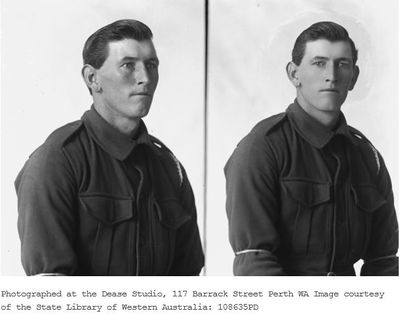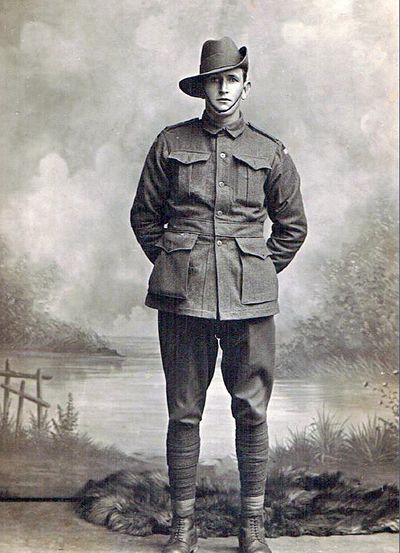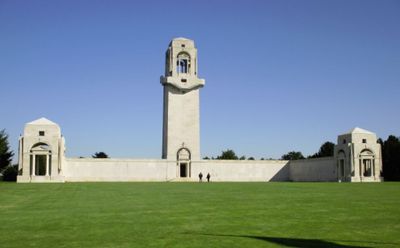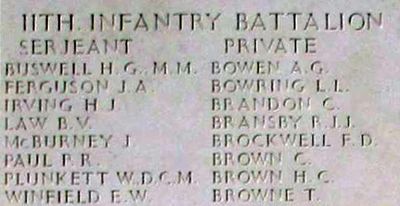Difference between revisions of "Richard John James Bransby"
From Our Contribution
(→External Links) |
|||
| (11 intermediate revisions by 3 users not shown) | |||
| Line 1: | Line 1: | ||
| − | {{ | + | {{infobox soldier |
| − | | | + | | image = [[File:Bransby_Richard_John_James_2.jpg|border|400px]] |
| − | + | | caption = State Library of WA 108635PD | |
| − | + | | image2 = [[File:Bransby_Richard_John_James.jpg|border|400px]] | |
| − | + | | caption2 = Photo courtesy Ron Barrett | |
| − | + | | dateofbirth = Not known | |
| − | + | | placeofbirth = Pingelly, Western Australia | |
| − | + | | death = 6 May 1917 | |
| − | + | | placeofdeath = Bullecourt, France | |
| − | | caption | + | | enlistmentage = 23 years, 4 months |
| − | | | + | | description = 6'0¾" (1.85m) tall; weight 162 lbs (73 Kg); fair complexion, blue eyes, light brown hair. |
| − | | caption2 | + | | height = 6'0¾" (1.85m) |
| − | | | + | | weight = 162 lbs |
| − | + | | complexion = fair | |
| − | + | | eyes = blue | |
| − | + | | hair = light brown | |
| − | + | | descriptionnote = | |
| − | + | | occupation = Mill hand or Labourer | |
| − | + | | religion = Church of England | |
| − | + | | address = Jarrahdale, Western Australia | |
| − | + | | relation = Father | |
| − | + | | nextofkin = Mr William Bransby, later changed to friend Miss Eva Rosey Day | |
| − | + | | regnumber = 3745 & [https://recordsearch.naa.gov.au/SearchNRetrieve/Interface/ViewImage.aspx?B=3113006 6277] | |
| − | + | | enlistmentdate = 14 Sep 1915 | |
| − | + | | rank = Private | |
| − | | | + | | unit = 11th Battalion, 20th reinforcement, posted to B Company |
| − | + | | embarkationdatefrom = 18 Sep 1916 | |
| − | | | + | | embarkationdateto = 2 Nov 1916 |
| − | + | | shipembarked = [[HMAT A46 Clan McGillivray]] | |
| − | + | | embarkedshipnote = | |
| − | + | | embarkationdatefrom2 = | |
| − | | | + | | embarkationdateto2 = |
| − | + | | shipembarked2 = | |
| − | + | | embarkedshipnote2 = | |
| − | | | + | | dateofreturnfrom = |
| − | + | | dateofreturnto = | |
| − | + | | shipreturned = | |
| − | | | + | | shipreturnednote = |
| − | + | | dateofreturnfrom2 = | |
| − | | | + | | dateofreturnto2 = |
| − | | | + | | shipreturned2 = |
| − | + | | shipreturnednote2 = | |
| − | | | + | | fate1 = Killed in Action 6 May 1917, 2nd Battle of Bullecourt |
| − | | | + | | fate2 = |
| − | + | | fate3 = | |
| − | + | | fate4 = | |
| − | | | + | | monument1 = [[Villers-Bretonneux Memorial]] |
| − | + | | monumentnote1 = | |
| − | | | + | | monument2 = |
| − | | | + | | monumentnote2 = |
| − | + | | monument3 = | |
| − | + | | monumentnote3 = | |
| − | + | | monument4 = | |
| − | + | | monumentnote4 = | |
| − | | | + | | monument5 = |
| − | + | | monumentnote5 = | |
| − | | | + | | monument6 = |
| − | + | | monumentnote6 = | |
| − | + | | monumentawm = [https://www.awm.gov.au/collection/R1669546 Australian War Memorial] | |
| − | | | + | | monumentawmnote = |
| − | + | | monumentother = | |
| − | + | | monumentothernote = | |
| − | | | + | | medal1 = [[British War Medal]] |
| − | + | | medal2 = [[Victory Medal]] | |
| − | + | | medal3 = | |
| − | | | + | | medal4 = |
| − | | | ||
| − | |||
| − | |||
| − | | | ||
| − | |||
| − | | | ||
| − | | | ||
| − | |||
| − | | | ||
| − | | | ||
| − | |||
| − | | | ||
| − | | | ||
| − | |||
| − | | | ||
| − | | | ||
| − | |||
| − | | | ||
| − | | | ||
| − | |||
}} | }} | ||
| Line 93: | Line 73: | ||
==War Service== | ==War Service== | ||
| − | Original enlistment was as James Bransby (3745), but he later re-enlistd as Richard John James Bransby (6277). There is nothing on his first set of service records to indicate why he was not sent to Egypt with the 12th reinforcements who he begun training with, or why the need to re-enlist. Records show him as part of the 12th reinforcement from 14 Sep 1915 to 24 Nov 1915. | + | Original enlistment was as James Bransby (3745), but he later re-enlistd as Richard John James Bransby (6277). There is nothing on his first set of service records to indicate why he was not sent to Egypt with the 12th reinforcements who he had begun training with, or why the need to re-enlist. Records show him as part of the 12th reinforcement from 14 Sep 1915 to 24 Nov 1915. |
| + | |||
| − | + | Enlisted a second time he was posted to the 22nd Depot on 16 May 1916 until 11 Jul 1916 and then on the 11th July to the 20th reinforcement draft. The period 25 Nov 1915 to 15 May 1916 is blank in his records. At six feet tall and sturdily built, in 1915 James gave his next of kin as his Father William Bransby, while a year later he was to record a Miss Eva Rosey Day (a friend living in Perth) as his NOK and he made provision of an allotment from his pay for her. Following training his draft sailed for England on 18 Sep 1916 aboard the [[HMAT A46 Clan McGillivray]], reaching Plymouth on 2 Nov 1916. A period of 3 days AWOL and its repercussions (120 hours of detention and 8 days pay in Nov 1916) meant there was a delay before he joined his battalion in France. | |
| − | |||
| − | At six feet tall and sturdily built, in 1915 James gave his next of kin as his Father William Bransby, while a year later he was to record a Miss Eva Rosey Day (a friend living in Perth) as his NOK and he made provision of an allotment from his pay for her. | ||
| − | |||
| − | Following training his draft sailed for England on 18 Sep 1916 aboard the [[HMAT A46 Clan McGillivray]], reaching Plymouth on | ||
| − | |||
| − | |||
| − | |||
| − | |||
| − | |||
| − | |||
| − | |||
| − | + | Richard proceeded to France on 10 Dec 1916 aboard [[HMT Golden Eagle]] from Folkestone, and in France he spent a month in depot units before joining the [[11th Battalion]] on 17 Jan 1917 at Bresle on the Amiens to Albert road along with 29 other men. The battalion's War Diary recorded that the weather that day was 'wet with rain and sleet that persisted all day'. The battalion was rebuilding between stints in the front lines. | |
| + | On 5 Mar 1917 James badly sprained his ankle while pushing rail trucks and was seen by the [[1st Field Ambulance]] before being treated at the 45th Casualty Clearing Station and then the 8th General Hospital in Rouen. He did not return to his unit until 1 May 1917, when they were located at Haplincourt south east of Bapaume. | ||
| − | The German troops attacked again at 1:00am on the 6th of May before being driven off by machine gun, Lewis gun, rifle fire and rifle grenades. At 5:00am they tried again before being halted by friendly artillery and they then turned to using flame throwers and bombing tactics to take ground on the battalions right flank. The battalion was able to regain any ground lost during the attacks, but suffered heavy casualties in doing so. They were also spasmodically bombarded throughout the day. | + | Back with the 11th Battalion, he found them busy on railway construction work and improving their defensive line. On the 3rd of May the battalion received a warning order to be prepared to move at short notice and then to move through the night from their position at Haplincourt to a new one in the Beughy-Ytres line. The following morning they moved to the sunken road near Noreuil where they relieved the 4th Battalion in the front line opposite the Hindenburg Line. On the 5th, having successfully relieved the 4th Battalion by 4:30am, their area was intensively shelled in the early morning and again in the afternoon causing casualties. The weather was described by the Battalion's War Diary as being fine and bright. That evening an enemy attack on their position was completely repulsed by friendly artillery before hot food was received in the front line via horse drawn limbers and carrying parties from other units. The German troops attacked again at 1:00am on the 6th of May before being driven off by machine gun, Lewis gun, rifle fire and rifle grenades. At 5:00am they tried again before being halted by friendly artillery and they then turned to using flame throwers and bombing tactics to take ground on the battalions right flank. The battalion was able to regain any ground lost during the attacks, but suffered heavy casualties in doing so. They were also spasmodically bombarded throughout the day. |
| − | |||
| + | As best can be discovered from the battalion's war diary, Richard lost his life as a result of one of these attacks or from the heavy German bombardment. James' records do not tell us whether his injury was caused by bullet or shrapnel, so we are left to deduce that, as there was no grave (he is memorialised on the [[Villers-Bretonneux Memorial]], he was very possibly a victim of artillery bombardment with no identifiable body. | ||
His military records include a letter from Miss Eva Rosey Day pleading for some small memento of the man that she was to marry on his return from the war. The Army in its great wisdom, despite Eva being acknowledged by James through her receiving part of his pay, ignored Eva when it came to the issue of medals and commemorative material, with his father receiving all such items. Eva does receive one of James' identity discs implying that at some point his body was identified before it was lost for all time. | His military records include a letter from Miss Eva Rosey Day pleading for some small memento of the man that she was to marry on his return from the war. The Army in its great wisdom, despite Eva being acknowledged by James through her receiving part of his pay, ignored Eva when it came to the issue of medals and commemorative material, with his father receiving all such items. Eva does receive one of James' identity discs implying that at some point his body was identified before it was lost for all time. | ||
| Line 129: | Line 100: | ||
==External Links== | ==External Links== | ||
| + | *[https://aif.adfa.edu.au/showPerson?pid=30905 AIF Project] | ||
| + | *[https://rslvirtualwarmemorial.org.au/explore/people/351846 RSL Memorial] | ||
{{DEFAULTSORT:Bransby , Richard John James}} | {{DEFAULTSORT:Bransby , Richard John James}} | ||
[[Category:Soldier]] | [[Category:Soldier]] | ||
| + | [[Category:Born Australia]] | ||
[[Category:Born WA]] | [[Category:Born WA]] | ||
| − | [[Category: | + | [[Category:Killed in action]] |
| + | [[Category:1917 KIA]] | ||
[[Category:1917 Deaths]] | [[Category:1917 Deaths]] | ||
[[Category:Mill hand]] | [[Category:Mill hand]] | ||
[[Category:Church of England]] | [[Category:Church of England]] | ||
| + | [[Category:Serpentine-Jarrahdale]] | ||
Latest revision as of 02:28, 21 August 2021
 State Library of WA 108635PD | |
 Photo courtesy Ron Barrett | |
| Personal Information | |
|---|---|
| Date of Birth |
Not known "Not known" contains an extrinsic dash or other characters that are invalid for a date interpretation. |
| Place of Birth | Pingelly, Western Australia |
| Death | 6 May 1917 |
| Place of Death | Bullecourt, France |
| Age at Enlistment | 23 years, 4 months |
| Description |
6'0¾" (1.85m) tall ; 162 lbs 73.482 kg ; fair complexion ; blue eyes ; light brown hair |
| Occupation | Mill hand or Labourer |
| Religion | Church of England |
| Address | Jarrahdale, Western Australia |
| Next of Kin | Father , Mr William Bransby, later changed to friend Miss Eva Rosey Day |
| Military Information | |
| Reg Number | 3745 & 6277 |
| Date of Enlistment | 14 Sep 1915 |
| Rank | Private |
| Unit/Formation | 11th Battalion, 20th reinforcement, posted to B Company |
| Date of Embarkation | 18 Sep 1916 ‒ 2 Nov 1916 |
| Ship Embarked On | HMAT A46 Clan McGillivray |
| Fate | Killed in Action 6 May 1917, 2nd Battle of Bullecourt |
| Monument |
Villers-Bretonneux Memorial Australian War Memorial |
| Medals |
British War Medal Victory Medal |
Contents
Pre War
War Service
Original enlistment was as James Bransby (3745), but he later re-enlistd as Richard John James Bransby (6277). There is nothing on his first set of service records to indicate why he was not sent to Egypt with the 12th reinforcements who he had begun training with, or why the need to re-enlist. Records show him as part of the 12th reinforcement from 14 Sep 1915 to 24 Nov 1915.
Enlisted a second time he was posted to the 22nd Depot on 16 May 1916 until 11 Jul 1916 and then on the 11th July to the 20th reinforcement draft. The period 25 Nov 1915 to 15 May 1916 is blank in his records. At six feet tall and sturdily built, in 1915 James gave his next of kin as his Father William Bransby, while a year later he was to record a Miss Eva Rosey Day (a friend living in Perth) as his NOK and he made provision of an allotment from his pay for her. Following training his draft sailed for England on 18 Sep 1916 aboard the HMAT A46 Clan McGillivray, reaching Plymouth on 2 Nov 1916. A period of 3 days AWOL and its repercussions (120 hours of detention and 8 days pay in Nov 1916) meant there was a delay before he joined his battalion in France.
Richard proceeded to France on 10 Dec 1916 aboard HMT Golden Eagle from Folkestone, and in France he spent a month in depot units before joining the 11th Battalion on 17 Jan 1917 at Bresle on the Amiens to Albert road along with 29 other men. The battalion's War Diary recorded that the weather that day was 'wet with rain and sleet that persisted all day'. The battalion was rebuilding between stints in the front lines.
On 5 Mar 1917 James badly sprained his ankle while pushing rail trucks and was seen by the 1st Field Ambulance before being treated at the 45th Casualty Clearing Station and then the 8th General Hospital in Rouen. He did not return to his unit until 1 May 1917, when they were located at Haplincourt south east of Bapaume.
Back with the 11th Battalion, he found them busy on railway construction work and improving their defensive line. On the 3rd of May the battalion received a warning order to be prepared to move at short notice and then to move through the night from their position at Haplincourt to a new one in the Beughy-Ytres line. The following morning they moved to the sunken road near Noreuil where they relieved the 4th Battalion in the front line opposite the Hindenburg Line. On the 5th, having successfully relieved the 4th Battalion by 4:30am, their area was intensively shelled in the early morning and again in the afternoon causing casualties. The weather was described by the Battalion's War Diary as being fine and bright. That evening an enemy attack on their position was completely repulsed by friendly artillery before hot food was received in the front line via horse drawn limbers and carrying parties from other units. The German troops attacked again at 1:00am on the 6th of May before being driven off by machine gun, Lewis gun, rifle fire and rifle grenades. At 5:00am they tried again before being halted by friendly artillery and they then turned to using flame throwers and bombing tactics to take ground on the battalions right flank. The battalion was able to regain any ground lost during the attacks, but suffered heavy casualties in doing so. They were also spasmodically bombarded throughout the day.
As best can be discovered from the battalion's war diary, Richard lost his life as a result of one of these attacks or from the heavy German bombardment. James' records do not tell us whether his injury was caused by bullet or shrapnel, so we are left to deduce that, as there was no grave (he is memorialised on the Villers-Bretonneux Memorial, he was very possibly a victim of artillery bombardment with no identifiable body.
His military records include a letter from Miss Eva Rosey Day pleading for some small memento of the man that she was to marry on his return from the war. The Army in its great wisdom, despite Eva being acknowledged by James through her receiving part of his pay, ignored Eva when it came to the issue of medals and commemorative material, with his father receiving all such items. Eva does receive one of James' identity discs implying that at some point his body was identified before it was lost for all time.
Notes

